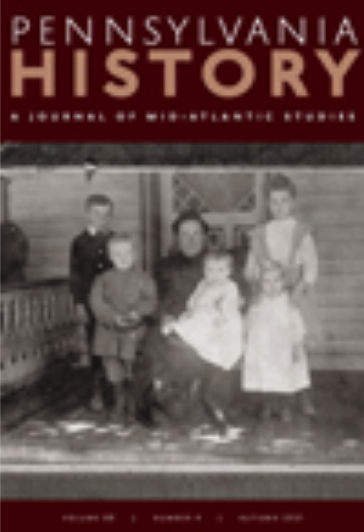
Pennsylvania History: A Journal of Mid-Atlantic Studies, Vol. 2, No. 2
- RUSK, William Sener
- Penn State University Press
- Pittsburgh, 1935. 1
- Ed. original: Pennsylvania History: A Journal of Mid-Atlantic Studies, Pittsburgh - 1935
- Enlace al capítulo citado de la Publicación [15-2-2023]
- Reproducción del artículo (English) [16-2-2023]
“WILLIAM THORNTON ARCHITECT”. Resumen del artículo.
Se cita en esta publicación al médico-arquitecto William Thornton, en el capítulo llamado “William Thornton, Architect” cuyas páginas se corresponden con las que van desde la 86 a la 98. En ellas se realiza una biografía del arquitecto, relatando tanto su fecha y lugar de nacimiento (”May 20, 1759 ; the place of birth is usually given as Tortola, the largest of the Virgin Islands, but perhaps more exactly, it should be given as the small neighboring island of Joost van Dyke”), como de fallecimiento ”He died in Washington, March 28, 1828”; los nombres de sus padres y la profesión del progenitor, así como su temprana muerte cuando Thornton tan solo tenía dos años, o el recorrido de sus estudios en medicina.
Se hace una breve descripción de su personalidad, “He was a scholar and a gentleman, full of talent and eccentricity, a Quaker by profession, a painter, a poet, and a horse-racer, well acquainted with the mechanic arts, at the head of the patent office, and was one of the original projectors of steamboats and the author of an excellent treatise on language, called “Cadmus”. He was a mand of infinite humor, humane and generous, yet fond of field sports, his company was a complete antidote to dullness”. Se relata su versatilidad, su carrera política, artística, como inventor (”the steamboats experiments”) , su disputa con el arquitecto Latrobe, a quién a menudo se ha considerado su antagonista. Se hace referencia a su membresía a “the American Philosophical Society”, a como cofundó “The Columbian Institute of Washington”, así como su participación en el proceso de colonización en África.
Se habla de su papel como comisario del distrito de Columbia durante un periodo de 5 años. De que las leyes sobre la edificación que se promulgaron el 20 de Julio de 1795 son de su autoría, y de que a fecha de 1799 ya mantenía correspondencia con Washington, en relación a los derechos públicos y privados de los espacios triangulares generados por la organización axial de las calles de la ciudad. Además como comisionario propuso la creación de una Universidad Nacional Pública.
En relación a su carrera como arquitecto , se cita en sus propias palabras, como nació su interés por la arquitectura: “The President and Secretary of State published a premium of a gold metal and a lot for a house in the city of Washington for the best plan and elevation of a capitol of the United States. I lamented not having studied architecture and resolved to attempt the grand undertaking and study simultaneously. I studied some months and worked almost night and day, but found I was opposed by regular architects from France and various other countries”, mencionando también el proyecto de Capitolio:
“The Capitol is after a design of my own…It will perhaps be deemed presumptuous that I began to study Architecture and to work for Prizes at the same time…A Plan for a Public Library in Philadelphia was proposed, and the Prize for the best Plan was a share in the company. I studied Architecture, set to work, and drew one of the ancient Ionic orders: This Order I admire much. The price was adjudged to me. What will not encouragement do? I afterwards had confidence enough to draw a Plan and Elevation for the Capitol of the United States; which after much deliberation, opposition and long examinations, was sentenced to me…”.
El capítulo continúa hablando de su trayectoría arquitectónica, mencionando proyectos y colaboraciones en proyectos tales como “The Philadelphia Library” o “the Roman Catholic Cathedral in Baltimore”, entre otros.
Ana RODRIGUEZ MARTÍNEZ